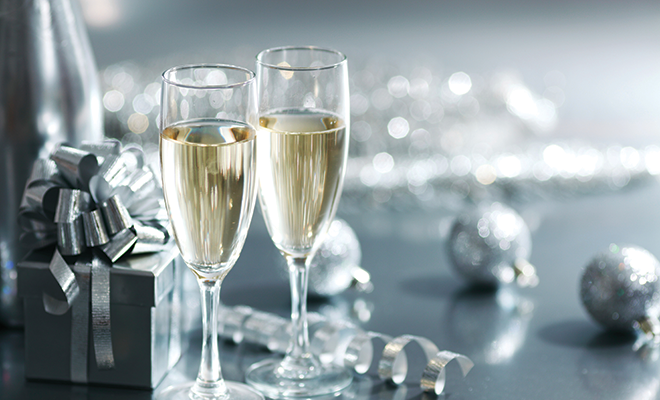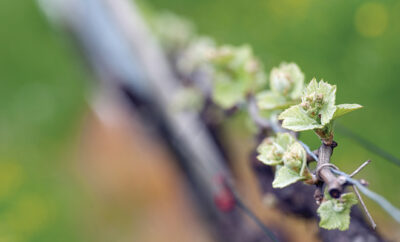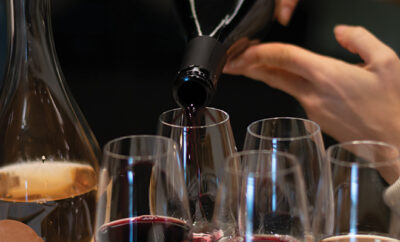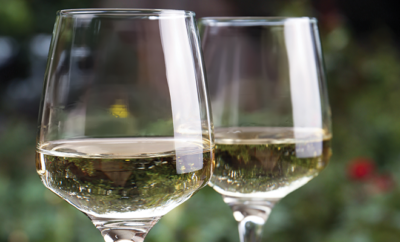
Toasting the Holidays!
Champagne sets the occasion right from the pop! Even an ordinary Tuesday can be made a bit better just sharing a bottle of bubbly and inviting the effervescence to entertain and delight you. Whether you choose a glass of champagne, prosecco, cava or sparkling wine, it’s easy to taste and choose your favorite bottle of bubbles no matter where they are produced.
For me, the first sip is filled with anticipation. Appreciation for sparkling wine came much later for me than many of my peers. That tart, super-dry or sometimes syrup-sweet flavor was often preceded by a fizz that literally tickled my upper lip. What was all the fuss about? And then my bubbly found me. A Ruinart Blanc de Blanc French champagne was served at an oyster and fondue gathering with live classical jazz on the beach. It was my epiphany! The delicate aroma of honeyed orange blossom and a constant bloom of the tiniest bubbles was seemingly endless. From that moment I associate champagne with great ambiance, friendship and happiness.
Champagne
True Champagne comes from the region of Champagne, France where all champagnes are a blend of sometimes 30 still, or non-sparkling, wines. The contents of each bottle have experienced a secondary fermentation fueled by trapped carbon dioxide gas that becomes those tiny fine bubbles, about 56 million per bottle. Known as méthode champenoise, this expensive per-bottle method was created in 1693 by Dom Pérignon, who created the first sparkling wine in Champagne.
Prosecco
It was Italy’s answer to Champagne in 1868; Carpene Malvoti produced prosecco’s sparkling wine in the tank versus the bottle, creating a more economical option to champagne. Now it’s produced all over the world. Bubbles are pleasant and less intense.
Cava
Spain created a sparkling wine in the 1700s, but didn’t see huge success until the mid-1800s when the region of Champagne, France, experienced severe plague of phylloxera that caused destruction of vital rootstock. Produced similarly by single bottle fermentation, cava must be made only in defined areas of Spain using specific grapes including chardonnay, pinot noir, garnacha and monastrell.
American Sparkling Wine and Champagne
In 1891 France staked their worldwide claim on méthode champenoise, creating the only place where Champagne could be produced. The U.S. agreed to the concept in the 1919 Treaty of Versailles but the Senate did not actually ratify the treaty, leaving a loophole that allowed producers to use the phrase California Champagne. Prohibition began in 1919 and wiped out most of the legitimate wine market in America. Even though Prohibition ended in 1933, it took another 40 years for the American wine industry to regain successful footing. Over time, many American wineries perfected their processes and labeled their wine as méthode tranditionalle.
Sparkling wine makes a great gift by the bottle or by the experience. If you’re looking for something unique this holiday season, why not explore sparkling wines in a setting where tasting and learning is an immersive experience? Schramsberg, Krug, Gloria Ferrer and Domaine Carneros invite their guests to walk the vineyards, absorb the terroir and taste the unique sense of style and place in each glass of champagne.
Splitting Bubbles
With the availability of sparkling wines in 187.5ml splits and 375ml half-bottles, it’s easy to enjoy one or two glasses without opening a standard 750ml bottle. The smaller sizes are also great for gift giving or adding to a gift basket of goodies. If you need to cap a standard bottle, the sparkling wine stoppers on the market do a great job of sealing your bubbles fairly tightly, even overnight.
Keep sparkling wines chilled within reach for easy pairing with nearly any menu from appetizers to dessert and for any gathering, party or last-minute gift. Bubbles can be enjoyed day or night Remember that bottles of sparkling wine are made with thicker glass to contain the CO2 so they take longer to chill to the perfect temperature of about 50 degrees.
Is Champagne better than sparkling wine? Your palate is the judge. In 1880, Mr. Schram, California proprietor of Schramsberg Wines, served his Anderson Valley sparkling wines to an early wine tourist, Robert Louis Stevenson, who stated, “Wine is bottled poetry.” I couldn’t agree more! ■
Sources: vinepair.com, karenmacneil.com, winefolly.com and en.wikipedia.org.
How to Choose?
The wine label can be tricky for all sparkling wines. Here are some helpful terms that nearly every producer uses.
Extra Brut: Extremely dry non-sweet sparkling wine with 0 – .6 percent sugar
Brut: Very dry, not sweet with less than 1.5 percent residual sugar
Extra Dry: Considered “even” and off dry but not sweet, containing 1.2-2% sugar
Sec: Not dry, lightly sweet on the tongue, 1.7 – 3.5 percent sugar
Demi-Sec: Officially sweet with nearly 5 percent sugar
Doux: The sweetest, like nectar, with 5 percent sugar or more







